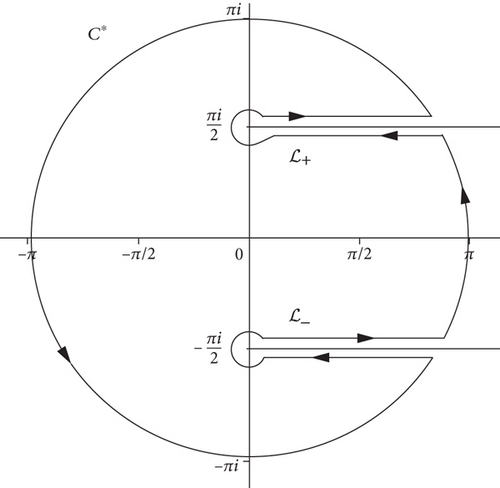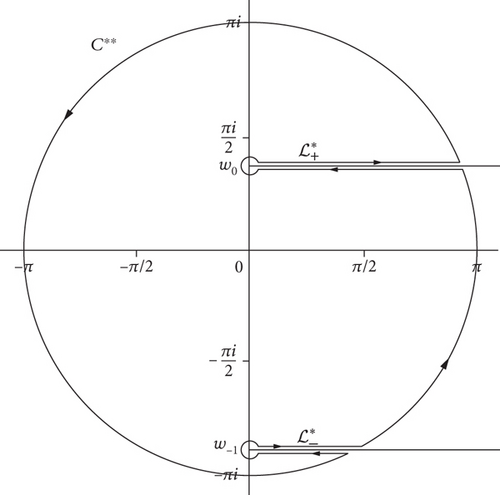Asymptotic Expansions for Large Degree Tangent and Apostol-Tangent Polynomials of Complex Order
Abstract
This paper provides asymptotic expansions for large values of n of tangent and Apostol-tangent polynomials of complex order. The derivation is done using contour integration with the contour avoiding branch cuts.
1. Introduction
When μ = 1 and μ = λ = 1, (1) and (2) reduce to the classical tangent polynomials, respectively (see [1]).
It is worth mentioning that results obtained in [2, 3] may have potential applications in mathematics and physics. More precisely, the numerical values of the zeros of the tangent polynomials may represent important values in engineering and physics while the twisted q-analogue of tangent polynomials may be used in quantum physics, particularly in the study of quantum groups and their representation theory.
Ryoo [4] introduced a variation of tangent numbers and polynomials, known as twisted tangent numbers and polynomials, associated with the p-adic integral on ℤp. Through his work, Ryoo presented intriguing findings and established connections related to these concepts. In addition, Ryoo [5] explored differential equations arising from the generating functions of generalized tangent polynomials and derived explicit identities for them. Furthermore, Ryoo [6] investigated the symmetry property of the deformed fermionic integral on ℤp, which is a mathematical structure defined over a prime field. Specifically, he focused on establishing recurrence identities for tangent polynomials and alternating sums of powers of consecutive even integers within this context. These discoveries expand our knowledge and understanding of this specialized area of mathematics, providing insights into its unique properties and potential applications across different domains. Moreover, a study by Corcino et al. [7] obtained the Fourier expansion of tangent polynomials of integer order.
In this paper, the same method described by Lόpez and Temme ([8], p. 4) has been followed in deriving the asymptotic expansion which only gives a first-order approximation. C. Corcino and R. Corcino ([9], p. 2) describe a similar method and provide a first-order and second-order approximations.
2. Asymptotic Expansions
In this section, the asymptotic expansions for large values of n of tangent and Apostol-tangent polynomials of complex order are derived.
2.1. Tangent Polynomials of Complex Order μ

The following lemma gives the contribution from the circular arc C∗.
Lemma 1. The integral along C∗ is O((π)−n). That is,
Proof. Taking the modulus of the integral, we have
This proves the lemma.
Remark 2. Lemma 1 shows that, for large values of n (as n⟶∞), the contribution from the circular arc C∗ is exponentially small with respect to the main contributions.

Consequently, we have the following theorem.
Theorem 3. As n⟶∞, μ and z are fixed complex numbers.
A first-order approximation is obtained by taking and for and , respectively, and taking the first term of the sum. This is given in the following theorem.
Theorem 4. As n⟶∞, μ and z are fixed complex numbers.
A second-order approximation is given as follows.
Theorem 5. As n⟶∞, μ and z are fixed complex numbers.
2.2. Apostol-Tangent Polynomials of Complex Order μ
We apply the same method as in the previous subsection.

Remark 6. It follows from Lemma 1 that the contribution from the circular arc C∗∗ is also O((π)−n), so that, for large values of n (as n⟶∞), it is exponentially small with respect to the main contributions.
Hence, we have the following theorem.
Theorem 7. As n⟶∞, μ and z are fixed complex numbers.
A first-order approximation is obtained by taking h0 and f0 for hk and fk, respectively, and taking the first term of the sum. This is given in the following theorem.
Theorem 9. As n⟶∞, μ and z are fixed complex numbers.
3. Summary
These findings contribute to our comprehension of the behaviors exhibited by these polynomials and can prove beneficial in various applications that necessitate approximations for significant values of n.
Conflicts of Interest
The authors declare that they have no conflicts of interest.
Acknowledgments
The authors would like to thank the Cebu Normal University (CNU) for funding this research project through its Research Institute for Computational Mathematics and Physics (RICMP).
Open Research
Data Availability
The articles used to support the findings of this study are available from the corresponding author upon request.




